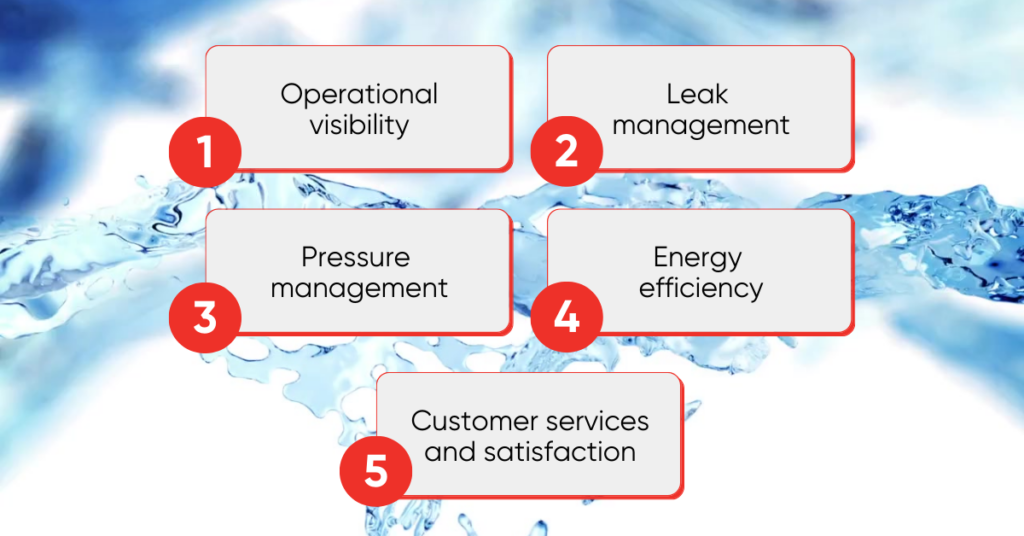However, water utilities face numerous challenges such as improving the operational efficiency, protecting the revenue, equilibrating financial and economic, and achieving sustainability-related goals.
In this article, we will bring up the challenges experienced by water utilities and potential solutions, including operational visibility, leak management, pressure management, and energy efficiency. We will explore how innovative solutions can address these challenges and pave the way for optimized management and operations.

Most common challenges water utilities face
1. Operational visibility
Water utilities often struggle with limited visibility into their operational data, making it difficult to effectively manage their water networks. The lack of real-time insights can lead to increased downtime, maintenance costs, and non-revenue water losses.
To address this issue, integrated visualization solutions offer comprehensive surveillance of water network operations, enabling utilities to view their networks and assets in a holistic manner. By utilizing advanced digital technologies associated with sensor deployed in the system allows automated calculations, such as the IWA Water Balance, and utilities can measure losses, monitor non-revenue water, and make data-driven decisions to optimize operations, reduce labor costs, and enhance asset management.
2. Leak management: Proactively detecting and mitigating leaks
Secondly, the combination of aging water infrastructure, adverse operational conditions and extreme weather conditions and events encourage water utilities in better managing leakage. Traditional methods of leak detection can be time-consuming and costly.
Using Geospatial AI-powered solutions, however, provides a distinct advantage by remotely identifying potential breach areas before failures occur. By obtaining insights into the condition of the entire network, utilities can proactively reduce non-revenue water losses, optimize maintenance and modernization efforts, and minimize the time and expense required to locate leaks. This method enables utilities to be proactive in preserving precious water resources and cutting costs.
3. Pressure management
Further, pressure management is an operational daily routine for water utilities. Maintaining optimal water pressure throughout the distribution network is complex and represents a significant challenge. From one side, aging infrastructure and system inefficiencies can lead to low pressure. From other hand, high water pressure occurs due to network topography, pumping or some water distribution conception. The excessive pressure can put addition stress on the pipes, joints, and fittings, leading to higher rates of leakages. These variations can strain the water infrastructure, leading to leaks, bursts and increased maintenance requirements. In addition, excessive pressure in the distribution system also translates into increased energy consumption. Inconsistent or inadequate water pressure can lead to customer dissatisfaction.
Utilities must balance pressure to meet consumer needs while avoiding issues like reduced flow or infrastructure failures. Fluctuating demand, leaks, and aging infrastructure further complicate the task.
Efficient pressure management involves monitoring, adjustments, maintenance, and upgrades. It is essential to strike a balance between energy consumption and water supply. Overcoming these challenges ensures reliable service, decreased water loss, and increased customer satisfaction.
4. Smart pumping optimization: enhancing energy efficiency
The pumping operation of water utilities faces several challenges that can impact efficiency, reliability, and overall water system performance. Energy consumption cost, variable demand, aging infrastructure, system hydraulics and pressure management, emergency response and resilience are some common challenges.
Smart pumping optimization is a technique that utilizes advanced technologies and data analytics to optimize the operation of pumping systems in water utilities. It involves the integration of real-time sensors, data and software interaction, control algorithms to dynamically manage pumping operations. Traditional approaches based on reservoir water levels or network pressure may not be adequate for optimizing efficiency. By continuously monitoring and adjusting pump performance, utilities can minimize energy consumption, lower maintenance costs, and comply with environmental regulations.
This approach not only improves operational efficiency but also contributes to global efforts in reducing greenhouse gas emissions.
5. Billing support: Increasing customer satisfaction
Lastly, effective billing process are crucial for water utilities to accurately measure and charge for water usage, recover costs, and maintain financial sustainability. Additionally, clear and transparent billing practices enhance satisfaction and trust in the utility’s services.
Metering, meter reading, consumption calculations, bill generation, payment collection are one of the common activities related to water billing. Nowadays, water utilities are looking for the adoption of digital technologies to improve the customer services and protecting and monitoring the revenue of water utilities.
To address these challenges, a customer-centric approach, investment in reliable invoicing systems, effective communication strategies, and ongoing enhancement of customer service processes are required. By prioritizing customer satisfaction and addressing billing issues, water utilities can improve customer relationships and service quality overall.
Moreover, it is crucial for water utilities to embrace technology and sustainable practices to achieve efficiency and sustainability in their operations, ensuring the availability and conservation of water resources for the benefit of all.
Digitalized water solutions based on the Internet of Things (IoT) provide the necessary tools to address and overcome the challenges facing modern water utilities. To maintain a sustainable technical and financial operation of water utilities, we offer a variety of technological components and services tailored to today’s and tomorrow’s needs. Utilizing digital technology and data-driven solutions has redefined business procedures and processes. On the water market, the adoption of data-driven solutions is influenced by three factors: increasing efficiency, reducing costs, and complying with regulations. To create value for utilities, our digital solutions focus on two main areas: operational efficiency and revenue protection.





